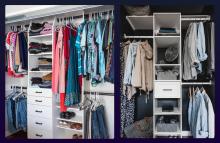11 Bathroom Problems to Assess Before Buying a House
- By Philmore Thompson
- Jul 26, 2019
-
9m
-
4
- RSS
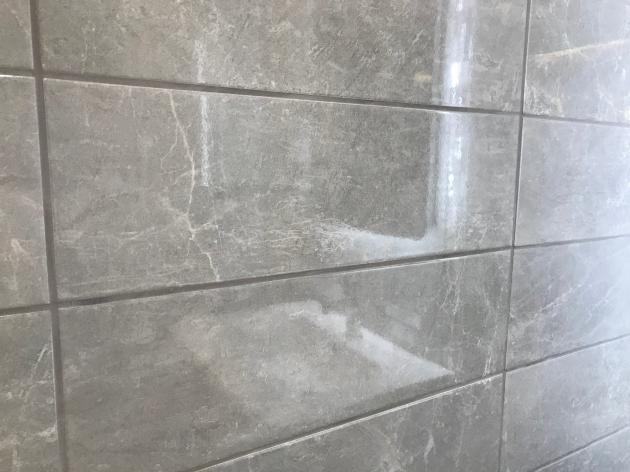
When buying a new home, you need to inspect all areas to find out the problems you could face if you make the purchase, so that you are aware of the possibility of costly repairs. Let's now look at the sort of problems you should check out for in bathrooms.
Related Articles
Poor Ventilation
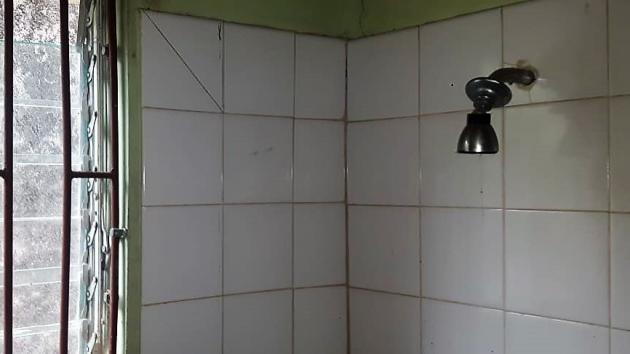
See if the bathroom has a window or ventilation system that will be able to remove moisture and odours from the room. Remember, we all use the bathroom to clean our bodies and remove any waste we produce. Hot water in bathrooms make them steamy and humid, allowing moisture to settle if there is no way of escape. In addition, urine and faeces carry foul odour. So, when buying a home, check to make sure that windows can be opened and the ventilation system actually works to replace "polluted" air from the inside with fresh air from outdoors. If neither exists or fails to work as expected, odours will build up in the room and spread to the other areas of the house. That can't be pleasant, even though that will be the least of your problems. You'll find yourself mired in addressing other bathroom problems, e.g., mold and/or mildew.
Mold and Mildew
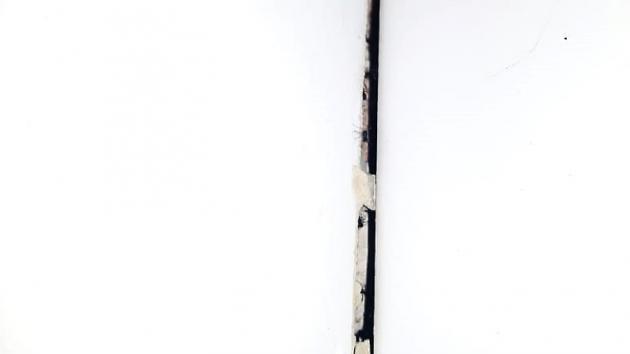
Mold and/or mildew are signs of other bathroom problems, e.g., poor ventilation, water leaks. Now what are they? Mold and mildew are just fungi (i.e., more than one fungus) that like to live on damp surfaces. As a result, if either mold or mildew are in a bathroom they are typically visible, and so, they should be one of the first things you look out for when viewing the bathrooms in a property you'd like to purchase. What's the difference? Mold is usually black or green and fuzzy or slimy in appearance, and grows underneath the surfaces of material that have gotten wet. Mildew is usually powdery or fluffy, appearing in patches of white, gray, or yellowish fungus, and grows on top of surfaces of moist, warm areas.
If you find either mold or mildew, you will need to assess the problem to see what underlying issue is the cause in order to get rid of the problem. Normally, mold and mildew pop up because of too much moisture in the air, which their spores desperately need in order to thrive. On that basis, if there are areas in a bathroom that haven't been kept dry, molds and/or mildew will appear. For example, this can happen if you've pipes leaking, water seeping behind tiles and settling in nooks and crannies, or poor ventilation. Alternatively, it could simply have been the fault of the previous owners who didn't clean the bathroom as needed.
So, when viewing bathrooms in your new home, take a keen visual inspection for signs of mold and mildew, paying close attention to those areas of the bathroom that get wet a lot.
Stains
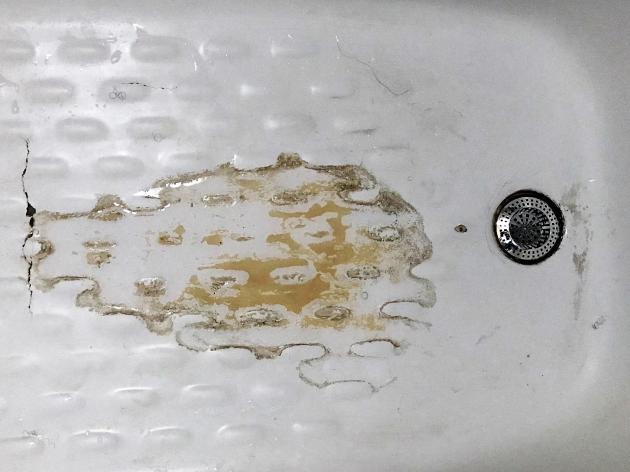
Look for stains in the bath, sink, walls, and toilet. Stains show how the bathroom was maintained, and could also indicate signs of other problems. Look for limescale, soap scum, rust, molds and mildew.
Luckily, you can remove most bathroom stains with a bit of cleaning product and elbow grease. For example, in the case of limescale stains like the one shown in the picture above, you can repeatedly cover the stained area with a cloth soaked in vinegar and let it sit overnight.
However, with molds or mildews you may also need to replace damaged caulk, grout, ceiling tiles, or drywall after you've fixed the source of the problem, and if you're lucky, you may be able to get away with simply repainting the clean, disinfected area. Also, bear in mind that if you've stains because of leaking pipes and/or drains, the plumbing must be repaired or replaced before addressing the stains. Otherwise, you'll be starting again from scratch in no time.
Water Damage
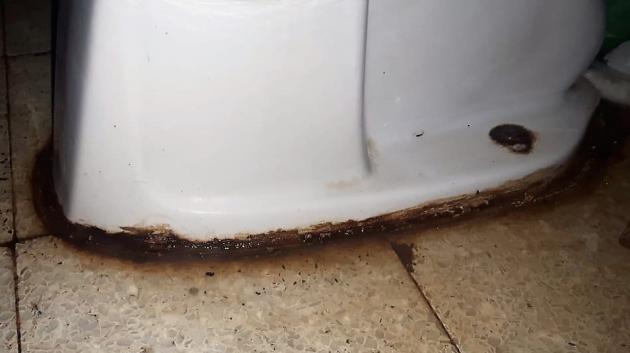
Look carefully at the ceiling, walls and floor to see if there are signs of water damage. Water damage is easily spotted, but not so easy to fix. Why? Water damage is caused by leaks, which means that you'll have to either dig into the walls or to delve beneath the flooring if you want to find the source of the leak and repair the damage. This can be quite costly.
Also, check out how well the sink sits on the counter where one exists. Is the seating of the toilet flush with the floor? Over time, either can cause water damage. The former will cause water to seep underneath the counter whenever water splashes on, and you can solve the problem quickly by simply re-caulking the gap. On the other hand, gaps between the floor and toilet may cause the toilet to rock when being used, thereby wearing out the wax gasket resulting in sewage leaks onto the floor. In addition, the gaps could cause odours to escape into the house.
Leaks
Even if there are no obvious signs of water damage as you look through a bathroom, you should get the water turned on to see if there are any leaks. The shower, faucet and toilet are common leaky areas. They may be minor problems, but at times they can be major.
If the washers are worn out in the mixer, faucet or tap, they just need changing. If on the other hand the mixer, faucet or valve is worn and damaged, the worn valve has to be replaced. Listen to the walls where the pipes are located for any leaks. Wastewater leaks will show up on the floor or between the bathroom and outside walls.
Related Articles
Clogged Drains
You should also turn on the different pipes in the bathroom, in the bath and sink, to see how quickly the water drains. Also, give the toilet a flush to see what happens. If there are any signs of slow or no drainage, this is cause for concern.
Blocked drains may be simple as well as tough to remove, depending on the reason for the blockage. Baths and sinks could be blocked by anything, with hair, soap scum, and pieces of soap being the typical culprits. For toilets, it's usually hard faeces, toilet tissue, baby wipes, paper towels, or whatever other materials that may have been used by the previous owners to clean their bodies after using the toilet. However, bear in mind that if kids were involved, you could find lots of other objects responsible for the blockage (e.g. toys).
Running Toilet

After flushing the toilet, listen to hear if the water stops filling the tank after a short period of time. At times, you'll hear the water to seep slowly into the bowl from the tank nonstop, which will not be good for your water bill. In many cases, you can get the toilet repaired easily by changing the rubber that releases the water from the tank into the bowl. If you have high water pressure problems, the water may force the float in the tank above the designed control limits, resulting in water always draining through the overflow into the bowl.
Water Pressure
Check the pressure of the water. However, you should note that the pressure may be high or low, depending on where you live and the time of day. You should also remember, that the National Water Commission has set times for turning water on or off in some areas.
If you find that the water pressure is low, you may have problems using the shower, which is the highest point of release. The positive here, is that, as a result, you'll likely have lower plumbing bills.
Whenever you find that the pressure is high, you should note this is a big and recurrent problem. When the water pressure is too high, pipes and other fixtures get damaged regularly. So, understand that you'll have to call the plumber often. Alternatively, figure out how to reduce the pressure in your new home.
Discoloured Water
While checking for leaks and pressure, it's advisable to notice the color of the water. It should be clear and free of debris. If it is discolored, the water may be collecting debris (e.g., sand) pumped from the pumping station during rainy periods, or there may be rust in the pipes especially when you're looking at older house with metal pipes. There could also be another form of contamination in the water system.
Some causes of water discoloration are temporary and not dangerous or hazardous for people. However, if there is rust in the pipes they will need to be removed and replaced. Such a project can be quite expensive.
Damaged Fixtures and Fittings
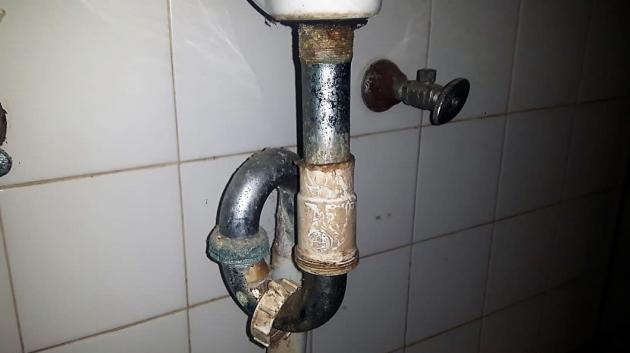
Look at all the bathroom fixtures for damages, e.g., the toilet, face basin, bath tub, flooring, walls, tiles, ceiling, and all visible pipes, taps, and faucets. It will be costly to replace any of these, and could be expensive to repair depending on the magnitude of the damage.
Foul Odour
Get a good smell of the bathroom. If you don't want to, you definitely have a problem. If the house is vacated you may not smell anything. However, when it is in use, foul smells may arise. As mentioned previously, you can also look for signs of possible odour problems (e.g., a rocking toilet, clogged drains, gaps between the toilet and the floor, and a leaking P-trap).
Other odour problems that are concealed include a blocked air vent, small cracks in P-traps and faulty plumbing.
Conclusion
When searching for these problems, be as thorough as possible. Some bathroom problems will show on sight, but others will only be recognised when the bathroom is in full use. Knowing what expenses you could have to deal with will give you better negotiating leverage. You'll be best placed if you were to get a certified building expert or plumber to provide clearer insights as to the level of bathroom problems you'll need to consider, and the possible cost for repairing. As the saying goes, 'let the buyer be weary'.
This article is for general information purposes only and does not constitute expert waste management advice. For more home maintenance-related articles and news, check us out at Nohuts.com.
